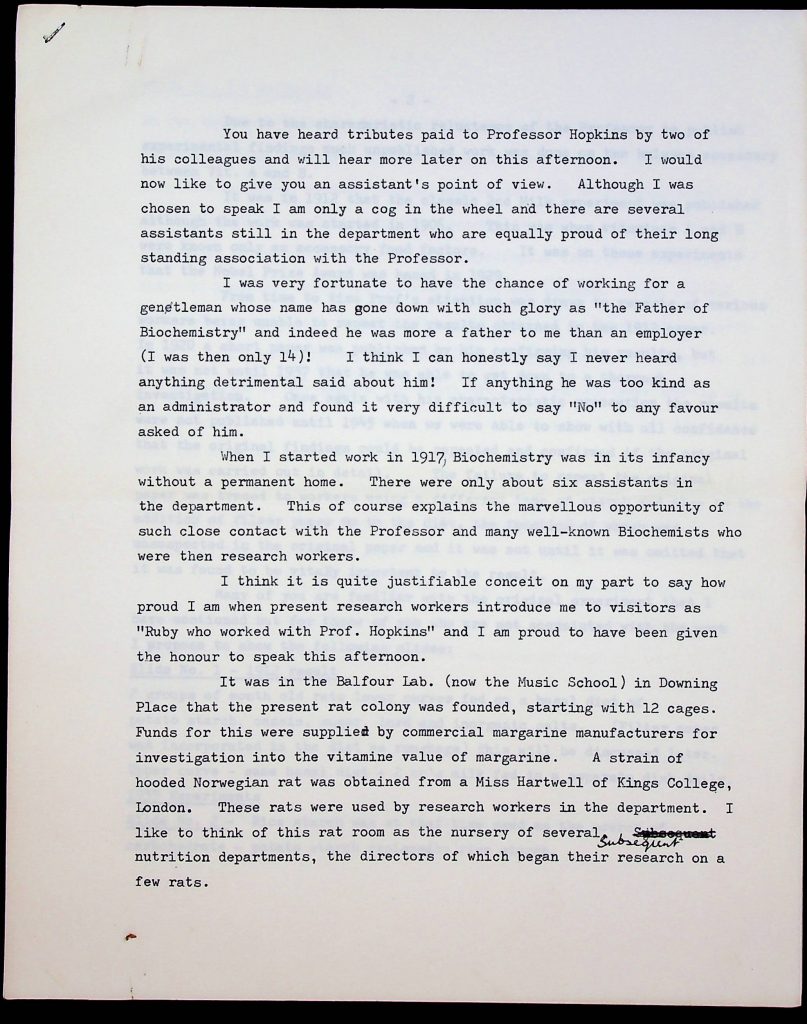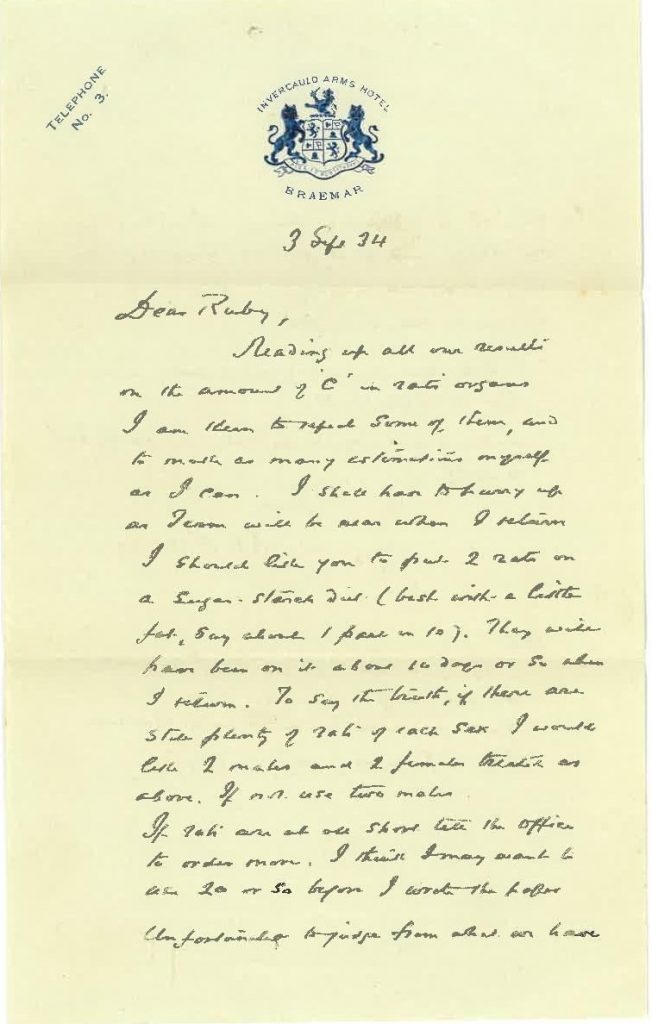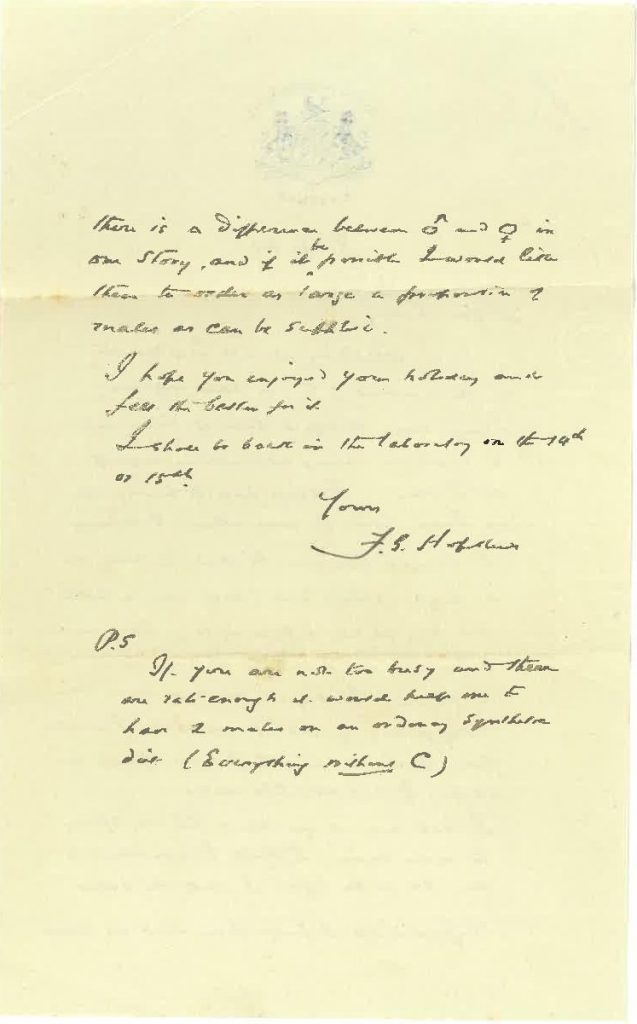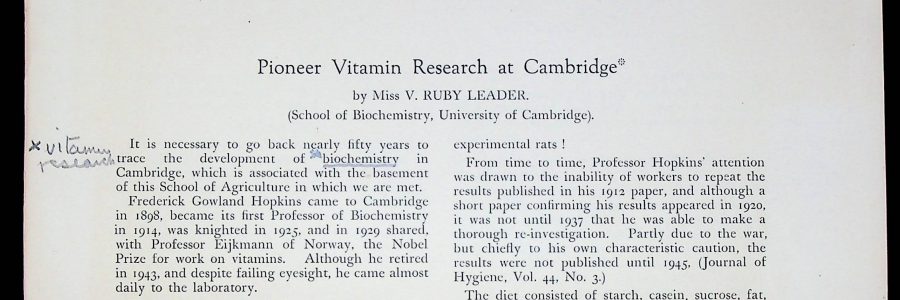
‘Ruby, who worked with Prof Hopkins’: papers of Ruby Leader, Animal Technician in the Department of Biochemistry
Biochemistry is particularly strongly represented in the University Library’s modern science archive holdings. The Department of Archives and Modern Manuscripts holds the personal paper collections of a number of early pioneers of biochemistry including Frederick Gowland Hopkins (1861-1947), Joseph Needham (1900-1995), Malcolm Dixon (1899-1985), Frank Young (1908-1988) and Rudolph Peters (1889-1982), and many more, as well as the records of the Elsie Widdowson Laboratory (formerly the Dunn Nutrition Laboratory) and the Low Temperature Research Station. In addition, the University Archives holds the institutional records of the Department of Biochemistry, 1918-2008.
Among these records of some of the most well-known figures in biochemistry is a single box of papers relating to the career of (Violet) Ruby Leader, technician in charge of the Animal Room at the Department of Biochemistry and stalwart member of staff. This seemingly inconsequential collection provides a small window into the nuts-and-bolts of the study of biochemistry in Cambridge from its infancy. Ruby Leader began working as an assistant in 1917 before the department had a fixed home in the University. Leader worked initially at the Balfour Laboratory in Downing Place and had responsibility for the department’s colony of rats. In this early period, the department’s research centred on the identification of further vitamins (the only known vitamins then being A and B) and the investigation of the vitamin value of margarine, this latter research supported by funding from various commercial margarine manufacturers.
As with the other assistants in what was still a relatively small department, Ruby Leader worked directly with Frederick Gowland Hopkins, the first Professor of Biochemistry at Cambridge. In a tribute given by Leader at the Sir F.G. Hopkins Centenary Tea Club meeting in 1961, she recalled:
I think it is quite justifiable conceit on my part to say how proud I am when present research workers introduce me to visitors as ‘Ruby, who worked with Prof Hopkins’ […]
In 1912, Hopkins had used animal feeding experiments, particularly with young rats, to demonstrate the presence of small quantities of unidentified substances which were essential to growth. Hopkins named these substances ‘accessory food factors’, later to be known as vitamines, as postulated by the Polish biochemist Casimir Funk, and then vitamins. Having realised that other researchers were unable to repeat his 1912 experiments with accuracy, Hopkins returned to this experiment later in his career. Hopkins’ obituary notice published in The Biochemical Journal in 1948 highlighted Ruby Leader’s significant contribution:
In 1945 Hopkins published work [see Hopkins and Leader, ‘On refection in rats …’] in which he examined the possibility that refection might have been in part responsible for his results in the vitamin work of 1912. Here, using a technique due to Miss Leader, the phenomenon of refection was completely eliminated by the administration of filter paper as roughage.
Little is known of Ruby Leader’s upbringing, education or training. As well as the 1945 paper co-authored with Hopkins, several of her articles were published in their own right in The Biochemical Journal. She was also an active member of the Animal Technicians’ Association from its establishment in 1950. Leader may have thought of herself as ‘only a cog in the wheel’ (her words at the 1961 Tea Club meeting) but she is frequently mentioned and fondly remembered in the various published departmental histories. Her long service was marked with special presentations in 1957 and 1962 to mark 40 and 45 years in the department (see UA BCHEM 1/5 for references), and in 1959 she was presented with a long service certificate by the University. Leader resigned from her post in 1966, just shy of half a century’s service.
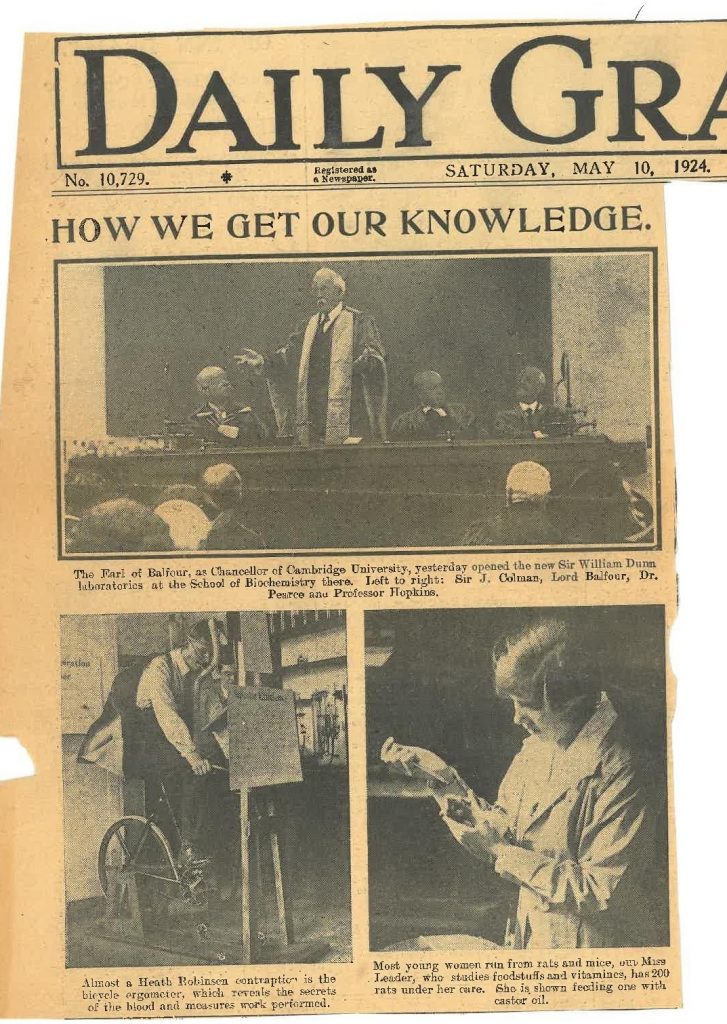
There are so few papers of women scientists in Cambridge and often they are ‘invisible’ to history, in part as many worked in lower status roles so that their personnel files, let alone their personal papers, were not preserved. Leader’s papers, now catalogued as MS Add. 10352, comprise offprints of her articles, two laboratory notebooks with numerous inserts, a cherished letter from Hopkins received in 1934, other offprints relating to Hopkins and the department, assorted handwritten notes, and a photograph of her at work in the laboratory. Also included in the collection is a 1924 newspaper cutting on the opening of the new Sir William Dunn Institute, featuring a photograph of the young Ruby Leader: ‘Most young women run from rats and mice but Miss Leader, who studies foodstuffs and vitamines, has 200 rats under her care’. A similar photograph can be seen in a wonderful digitised photograph album held by the Biochemistry Department.
Watch this space for a forthcoming blog-post on other recent accessions from the Department of Biochemistry.

